As the world shifts towards renewable energy, homeowners increasingly consider solar power a viable option. Integrated solar panels, an innovative alternative to traditional on-roof panels, have gained popularity thanks to their sleek design and practical benefits. But are they the right choice for your home? This comprehensive guide will help you understand the pros and cons of integrated solar panels, explore their costs, and dive into the factors to consider when choosing between them and other solar solutions.
This journey will explore how integrated solar panels work, their advantages and disadvantages, popular manufacturers, costs, comparison with solar roof tiles, maintenance requirements, and planning permission considerations. By the end, you will have the knowledge and confidence to decide whether integrated solar panels are the perfect fit for your home.
Key Takeaways
- Integrated solar panels offer cost-efficiency, aesthetic appeal and lightweight durability.
- Lower efficiency compared to traditional PV solar panels, retrofitting can be expensive and time-consuming.
- Consider factors such as aesthetics, cost & planning permission when choosing integrated solar panels for your home.
Understanding Integrated Solar Panels
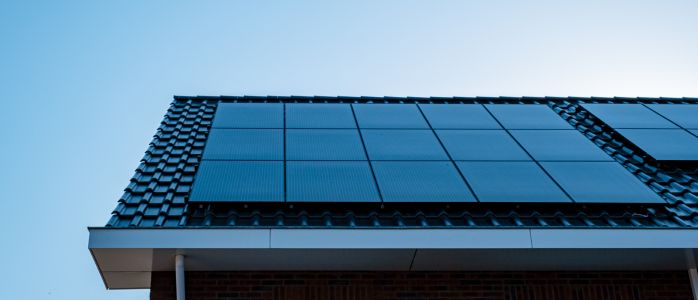
Integrated solar panels, including solar PV panels, are photovoltaic panels that replace roof tiles, generate electricity, and boast durability and weatherproof features. These differ from traditional on-roof solar panels in that they’re embedded into the roof structure, requiring the removal of the roof tiles, unlike the latter that sit atop the tiles. In roof solar panels mimic the appearance of roof tiles, providing a seamless and attractive solar solution that doubles as a roof covering.
Although integrated solar panels offer several advantages, such as aesthetic appeal and cost-effectiveness, they also have certain drawbacks. For instance, they typically have lower efficiency than traditional solar panels, and retrofitting them onto an existing roof can be challenging.
How They Work
Typically, integrating solar panels does not require modification to the underlying roof structure. Instead, the following process is followed:
- Roof tiles are removed.
- Plastic trays are affixed to the existing roof.
- The trays are secured with conventional framed solar panels.
- Slates are used to fill in the gaps around the solar panels.
This process allows integrated solar panels to replace normal roof tiles without altering the roof’s structure.
The primary distinction between integrated solar panels and regular on-roof solar panels lies in their installation. While integrated solar panels are embedded into the roof, replacing roof tiles, on-roof solar panels are installed on top of the roof tiles with the help of rails. This difference highlights the seamless panel and roof tiles integration in an integrated solar panel system.
Comparing with Traditional Solar Panels
In terms of aesthetics, integrated solar panels outshine traditional on-roof panels. They blend seamlessly with the roof tiles, providing a sleek, modern appearance that is visually appealing to many homeowners. In terms of weight, roof-integrated solar panels add minimal, if any, additional weight to your roof, making them a more convenient and safer option.
Integrated solar panels have lower efficiency when compared to traditional photovoltaic (PV) solar panels. This limits their ability to convert solar energy into electric energy. This is primarily due to the lack of air ventilation caused by their snug positioning within a tray. Despite this drawback, integrated solar panels are still attractive for those who prioritize aesthetics and lightweight design.
Advantages of Integrated Solar Panels
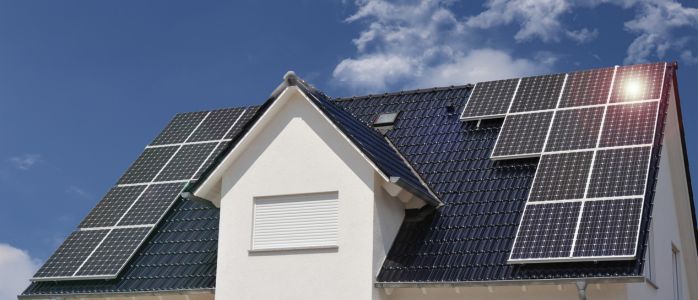
With their aesthetic allure, lightweight structure, and cost-effectiveness, integrated solar panels have an edge over traditional on-roof solar panels, making them an appealing option for new constructions and roof replacements. Homeowners and builders alike appreciate the sophisticated look of integrated solar panels as they harmonize with the roof and appear as an intended component rather than an additional element.
The benefits of integrated solar panels include:
- Enhanced installation convenience and reduced potential damage to the roof structure due to their lightweight construction
- Cost-effectiveness, especially for new builds and roof replacements, due to decreased installation and maintenance costs
- Increased efficiency
Aesthetic Appeal
A major draw of integrated solar panels is their aesthetically pleasing design. Unlike traditional on-roof solar panels, which can appear bulky and obtrusive, integrated solar panels blend seamlessly with the roof tiles, creating a contemporary and sophisticated look. This sleek design is particularly appealing to those who value the appearance of their property and wish to maintain a modern aesthetic.
Research has shown that 50% of respondents aged 13-40 find solar panels appealing, which suggests that integrated solar panels can enhance the visual appeal of a home to a broad demographic. By selecting integrated panels in colours and designs that match your home’s aesthetic, you can create a cohesive and attractive appearance that complements your property’s overall design.
Lightweight and Durable
Beyond their aesthetic allure, integrated solar panels boast a lightweight and durable design. Their lightweight construction ensures ease of installation and reduces the risk of damage to the roof structure. Integrated solar panels are also highly durable and can endure up to 25 years.
Furthermore, integrated solar panels have the following features:
- Designed to be wind-resistant, capable of withstanding strong winds
- Flush positioning within a tray provides increased resistance to environmental elements such as wind, rain, and snow
- Reduces the need for frequent maintenance
Cost-Effectiveness
As the cost of integrated solar panels has decreased, they have become a more cost-effective option for homeowners, mainly when installed during new-build projects or roof replacements. Integrated solar panels provide cost savings through decreased integrated solar panels cost, minimized maintenance costs, and increased efficiency.
Furthermore, integrated solar panels offer the following benefits:
- They can be installed quickly, typically in a matter of hours.
- Their installation process is expeditious, saving time and effort.
- They provide aesthetic benefits, enhancing the overall appearance of a home.
- They are a cost-effective choice for homeowners seeking an alternative to traditional solar panel systems.
Disadvantages of Integrated Solar Panels
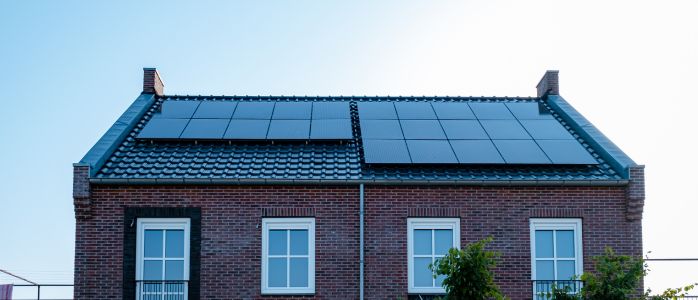
Despite their many benefits, integrated solar panels are not devoid of shortcomings. They generally demonstrate lower efficiency than traditional on-roof solar panels, with a 5-10% reduction in solar-generated electricity. This decrease in efficiency is due to the lack of air ventilation caused by their snug positioning within a tray, as mentioned earlier.
Another downside is the complexity and associated costs of retrofitting integrated solar panels onto an existing roof. Retrofitting integrated solar panels requires removing and installing roof tiles or slates, which can be time-consuming and costly. This drawback is specific to integrated solar panels and does not apply to on-roof solar panels.
Lower Efficiency
As previously mentioned, integrated solar panels are less efficient than traditional on-roof solar panels due to their lack of air ventilation. The snug positioning of integrated solar panels within a tray reduces airflow, leading to higher operating temperatures and lower efficiency in converting solar energy to electricity. This reduced efficiency can concern homeowners who prioritize energy generation and overall system performance.
It is important to weigh the aesthetic and practical benefits of integrated solar panels against their lower efficiency when deciding whether they are the right choice for your home.
While integrated solar panels may be less efficient, their advantages include:
- Sleek design
- Lightweight construction
- Easy installation
- Improved curb appeal
- Potential cost savings in the long run
These factors may make integrated solar panels a worthwhile investment for many homeowners.
Retrofitting Challenges
Installing solar panels into an existing roof can be a complicated task. It often requires a substantial financial investment, too. Removing and installing roof tiles or slates is necessary to accommodate the integrated solar panels, which can be time-consuming and expensive. This drawback is specific to integrated solar panels and does not apply to traditional on-roof solar panel installation, which is generally less complicated and costly.
If you are considering retrofitting integrated solar panels onto your existing roof, evaluating the potential costs and challenges is crucial. Sometimes, it may be more cost-effective and practical to opt for traditional on-roof solar panels or wait until a roof replacement is necessary to install integrated solar panels.
Popular Integrated Solar Panel Manufacturers
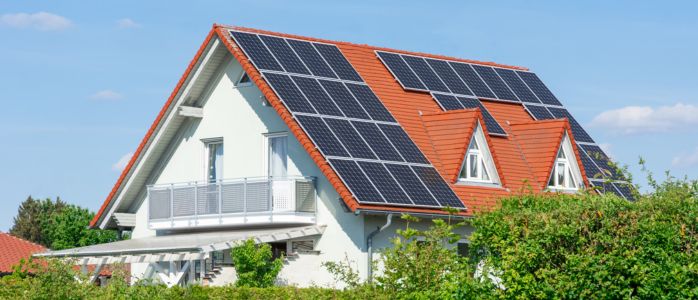
When exploring integrated solar panels, conducting thorough research on various manufacturers and their offerings is vital to identify the best match for your needs. Some popular manufacturers of integrated solar panels include:
- GB Sol
- Solarcentury
- Viridian Solar
- Redland
Each manufacturer offers unique products and features to cater to different homeowner preferences and requirements.
By comparing the offerings of these manufacturers, you can make an informed decision about which integrated solar panels are best suited for your home. Factors such as:
- aesthetics
- efficiency
- cost
- warranty
should be taken into consideration when choosing the right integrated solar panels for your property.
GB Sol
GB Sol is a leading supplier of comprehensive solar panel solutions, including the following products:
- RIS system: an award-winning product for full or part roof systems that has been fully tested by the Building Research Establishment (BRE) and is MCS certified (or equivalent)
- PV slates
- Infinity solar roofs
- Integrated solar roofs
- Battery storage systems
Utilizing GB Sol’s products provides aesthetic appeal, lightweight and resilient construction, and cost-effectiveness. The wide range of offerings from GB Sol ensures that homeowners can find the perfect integrated solar panel solution to suit their needs and preferences.
Solarcentury
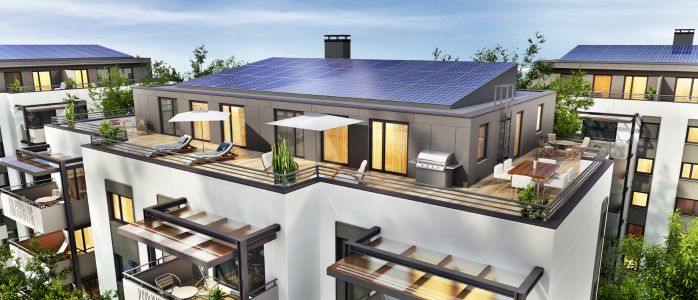
Solarcentury is another popular manufacturer of integrated solar panels, focusing on aesthetics and efficiency in their product offerings. Their integrated solar panel option, Sunstation Built-in Plus, provides a sleek and attractive design while maintaining high efficiency.
The Sunstation Built-in Plus system is an excellent choice for homeowners who prioritize aesthetics and energy generation. By selecting Solarcentury’s integrated solar panels, you can enjoy a visually appealing and complete solar roof system without sacrificing efficiency and performance.
Viridian Solar
Viridian Solar offers the ClearLine Fusion system, featuring low-profile aesthetics and module efficiency of 16.6%-19.2%. This system provides a clean, modern appearance while maintaining high efficiency, making it an attractive option for homeowners who value design and performance.
With its range of wattages and mounting options, the ClearLine Fusion system from Viridian Solar caters to various homeowner preferences and requirements. You can enjoy a sleek design without compromising efficiency and energy generation by choosing Viridian Solar’s integrated solar panels.
Redland
Redland specializes in integrated solar panels designed for durability and weather resistance. Their selection of pitched roof systems includes flat, profiled, and plain tiles manufactured from concrete, clay, or resin slate. In addition to their integrated solar panels, Redland also supplies roofing products such as tiles, slates, and fittings.
Engineered for strength and resilience to the elements, Redland’s integrated solar panels are an optimal choice for long-term use. Their lightweight design and straightforward installation make them a practical and cost-effective choice for homeowners seeking a durable, low-maintenance solar solution.
Integrated Solar Panel Costs in the UK
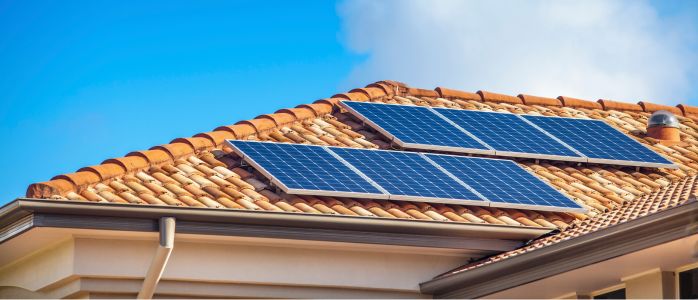
In the UK, the cost of integrated solar panels is on par with traditional on-roof solar installations. Factors determining the price include whether it’s a new build or retrofit, the manufacturer, and energy generation capacity. It is essential to consider these factors when evaluating the cost of integrated solar panels for your home.
For example, the cost of in-roof solar panel systems for new builds is approximately £1,200 per kWp, excluding VAT and scaffolding, which is congruent with the cost of on-roof systems. By researching and comparing the prices of various integrated solar panel systems and manufacturers, you can decide on the most cost-effective option for your home.
Integrated Solar Panels vs. Solar Roof Tiles
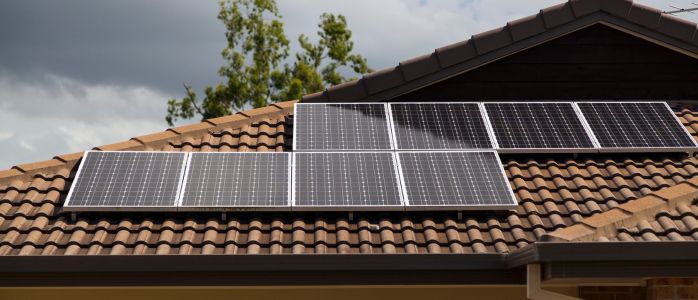
Integrated solar panels and in-roof solar systems, such as solar roof tiles, come in sleek designs that blend seamlessly with the roof’s aesthetics. However, they differ in their installation processes and costs. Integrated solar panels replace a section of the roof. In contrast, solar roof tiles replace individual tiles, making them an appealing option for those who want to maintain a more traditional appearance.
When deciding between integrated solar panels and solar roof tiles, it is essential to consider factors such as installation complexity, cost, and overall design. Both options provide a visually appealing solar solution, but their differences in installation and cost may sway your decision based on your specific needs and preferences.
Maintenance Requirements for Integrated Solar Panels
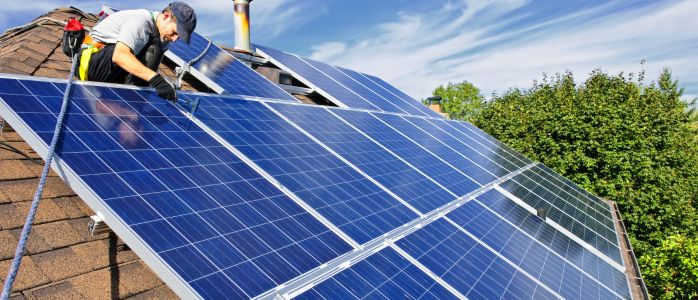
With no moving parts and brackets, integrated solar panels demand less maintenance than on-roof panels. However, they still require regular maintenance, such as debris cleaning, to ensure optimal performance and longevity.
Despite their reduced maintenance requirements, it is crucial to regularly inspect your integrated solar panels and address any issues promptly. By performing routine maintenance, you can ensure your integrated solar panels continue to generate electricity efficiently and provide long-lasting benefits for your home.
Factors to Consider When Choosing Integrated Solar Panels
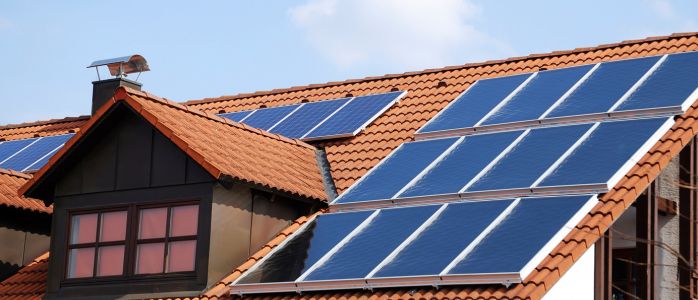
Several factors need consideration when selecting integrated solar panels for your home. Some of these factors include:
- Aesthetics
- Cost
- Efficiency
- Roof type
- Planning permission
All of these factors play a role in determining the best integrated solar panel solution for your property. It is essential to weigh the pros and cons of integrated solar panels compared to traditional on-roof panels and consider factors such as the manufacturer and specific product offerings.
By carefully evaluating these factors and comparing different integrated solar panel systems, you can decide the best solar solution for your home. Ultimately, the choice will depend on your needs, preferences, and budget.
Obtaining Planning Permission for Integrated Solar Panels

The lightweight and streamlined design of integrated solar panels can increase their likelihood of receiving planning permission in listed buildings or protected zones. Such panels are becoming more popular for use in these locations. Their cleaner finish and lack of additional weight make obtaining planning permission easier, especially for listed buildings and homes in conservation areas.
When considering integrated solar panels for your home, it is essential to research local planning regulations and restrictions to ensure your installation is compliant. By selecting integrated solar panels that meet planning permission requirements, you can avoid potential complications and enjoy the benefits of your solar installation without any legal concerns.
Summary
In conclusion, integrated solar panels offer numerous benefits, including aesthetic appeal, lightweight design, and cost-effectiveness. However, they also have drawbacks, such as lower efficiency and retrofitting challenges. By researching different manufacturers, comparing costs, and considering factors such as roof type and planning permission, you can decide on the best integrated solar panel solution for your home.
Whether you decide on integrated solar panels or another solar solution, the shift towards renewable energy is essential for a more sustainable future. By investing in solar power, you are improving the aesthetics and value of your home and contributing to a cleaner, greener world for generations to come.
Frequently Asked Questions
Are integrated solar panels more expensive?
Integrated solar panels are typically more cost-effective than regular solar panels, as they are cheaper to handle and install due to their lightweight nature. Integrated solar panels often lower installation costs, requiring fewer components and less installation labour. Additionally, integrated solar panels are more aesthetically pleasing, as they blend in with the roof of the building they are installed.
What are the disadvantages of integrated solar panels?
Integrated solar panels can be less efficient than on-roof solar panels due to their snug fit in the roof, reducing efficiency by up to 3%. However, integrated solar panels can still be an excellent option for homeowners who want to reduce their energy bills and use renewable energy. They are easy to install and require minimal maintenance, making them an excellent choice for those who want to go green without a lot of
What is an integrated solar panel?
Integrated Solar Panels, or In-roof Solar Panels, are designed to sit flush with your roof and replace the roof tiles, allowing them to be embedded into the roof. These panels are designed to be aesthetically pleasing and blend in with the roof while providing the same benefits as traditional solar panels. They are also designed to be easy to install and maintain, making them an excellent option for homeowners looking to reduce their energy costs.
Are inset solar panels less efficient?
Inset solar panels are generally less efficient than on-roof solar panels, with a 5-10% performance loss due to less air ventilation and higher temperatures. However, inset solar panels can be a great option for those who don’t have the roof space or the budget for on-roof solar panels. They are also easier to install and maintain and can be a great way to get started with solar energy
What is the main difference between integrated solar panels and traditional on-roof solar panels?
Integrated solar panels are embedded into the roof, replacing roof tiles, while traditional on-roof solar panels are installed on top of the existing roof tiles.
